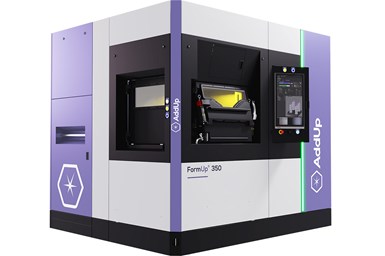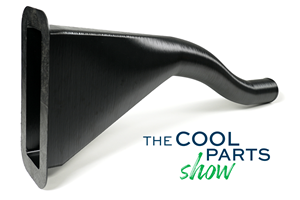AddUp Adds Constellium’s Aheadd CP1 Aluminum Alloy to Material Portfolio
The Aheadd CP1 aluminum alloy was developed by Constellium for the needs of additive manufacturing by laser powder bed fusion specifically for high-performance and lightweight applications.
Share
Read Next
AddUp has expanded its material portfolio by adding Constellium’s Aheadd CP1 aluminum alloy to its FormUp 350 machines, offering a high-performance alternative to traditional aluminum alloys for additive manufacturing (AM).
Constellium’s Aheadd CP1 alloy can now be used on AddUp FormUp 350 machines. This aluminum alloy is specially developed for the needs of AM and is said to provide an interesting alternative to traditional grades such as AS7 or AS10, with higher productivity and better performance for heat dissipation applications.
AddUp qualified the new aluminum alloy Aheadd CP1 for FormUp 350 machines. This alloy was developed by Constellium and was designed for the needs of AM by laser powder bed fusion (LPBF) specifically for high-performance and lightweight applications.
The current AM market is dominated by AS7 and AS10 grades (alloys of aluminum, silicon and magnesium, originally created for the foundry industry). Constellium offers an aluminum-iron-zirconium alloy with higher solderability which makes it possible to increase laser power and scan speed, and therefore to improve productivity. The gains can range depending on the type of part to be printed, and more could be achieved in the next years.
Above all, with Constellium alloy, post-build operations are simplified. “To obtain the best mechanical properties using AS7 and AS10 grades, several long and expensive post-build treatments must be carried out, such as hot isostatic pressing and, solution and aging, etc.,” says Frédéric Sar, Materials Officer at AddUp. “With Aheadd CP1, very similar material properties can be achieved with a simple heat treatment at 400°C.”
Saving time and money on these post-printing operations, which represent up to 40 to 50% of the cost of LPBF parts, can make a difference in the profitability of an application.
In detail, the mechanical properties of parts made by AddUp from Aheadd CP1 (particle size 20-63 micron) are close to those of AS7 in terms of hardness, at least equivalent in fatigue resistance and higher in ductility. These parts are also compatible with anodizing treatments to improve corrosion resistance.
Higher thermal conductivity of Aheadd CP1 compared to traditional aluminum alloys makes Constellium’s alloy a better candidate for heat exchanger applications. This alloy is stable up to 250°C without degrading its microstructure. Therefore, the parts made out of this material can be used at higher temperatures compared to AS7, which paves the way for lightweight applications for the aerospace industry.
All these characteristics make Aheadd CP1 a potential alternative to AS7 and AS10 alloys for 3D printing. This material was recently approved in the field of motorsports. Combining this material with performance of the AddUp FormUp 350 machine, increases the productivity without compromising the part quality. This material could quickly gain significant interest in many other industrial sectors, including aeronautics and aerospace.
- Read about AddUp’s participation in a $1.5 million USAF Research on IN-718 additive manufacturing. AddUp is partnering with Zeda to provide critical project support to provide the USAF with a set of manufacturing guidelines to maximize the capabilities of LPBF to meet fleet readiness and sustainment goals.
- Read about another Addup collaboration with Zeda — this time for aerospace and medical additive manufacturing. The first of eight AddUp FormUp 350 powder bed fusion machines deployed has been installed at Zeda to support its growth in the aerospace and medical sectors.
Related Content
Aircraft Ducts 3D Printed in Composite Instead of Metal: The Cool Parts Show #68
Eaton’s new reinforced PEKK, tailored to aircraft applications, provides a cheaper and faster way to make ducts compared to formed aluminum.
Read MoreAdditive Manufacturing Is Subtractive, Too: How CNC Machining Integrates With AM (Includes Video)
For Keselowski Advanced Manufacturing, succeeding with laser powder bed fusion as a production process means developing a machine shop that is responsive to, and moves at the pacing of, metal 3D printing.
Read More“Mantis” AM System for Spacecraft Uses Induction for Deposition
The metal 3D printing system melts wire without lasers. 30-foot-diameter parts are built on a rotary-feed system that eliminates the need for a large machine frame or gantry.
Read MoreAt General Atomics, Do Unmanned Aerial Systems Reveal the Future of Aircraft Manufacturing?
The maker of the Predator and SkyGuardian remote aircraft can implement additive manufacturing more rapidly and widely than the makers of other types of planes. The role of 3D printing in current and future UAS components hints at how far AM can go to save cost and time in aircraft production and design.
Read MoreRead Next
Alquist 3D Looks Toward a Carbon-Sequestering Future with 3D Printed Infrastructure
The Colorado startup aims to reduce the carbon footprint of new buildings, homes and city infrastructure with robotic 3D printing and a specialized geopolymer material.
Read MoreProfilometry-Based Indentation Plastometry (PIP) as an Alternative to Standard Tensile Testing
UK-based Plastometrex offers a benchtop testing device utilizing PIP to quickly and easily analyze the yield strength, tensile strength and uniform elongation of samples and even printed parts. The solution is particularly useful for additive manufacturing.
Read MoreBike Manufacturer Uses Additive Manufacturing to Create Lighter, More Complex, Customized Parts
Titanium bike frame manufacturer Hanglun Technology mixes precision casting with 3D printing to create bikes that offer increased speed and reduced turbulence during long-distance rides, offering a smoother, faster and more efficient cycling experience.
Read More





















